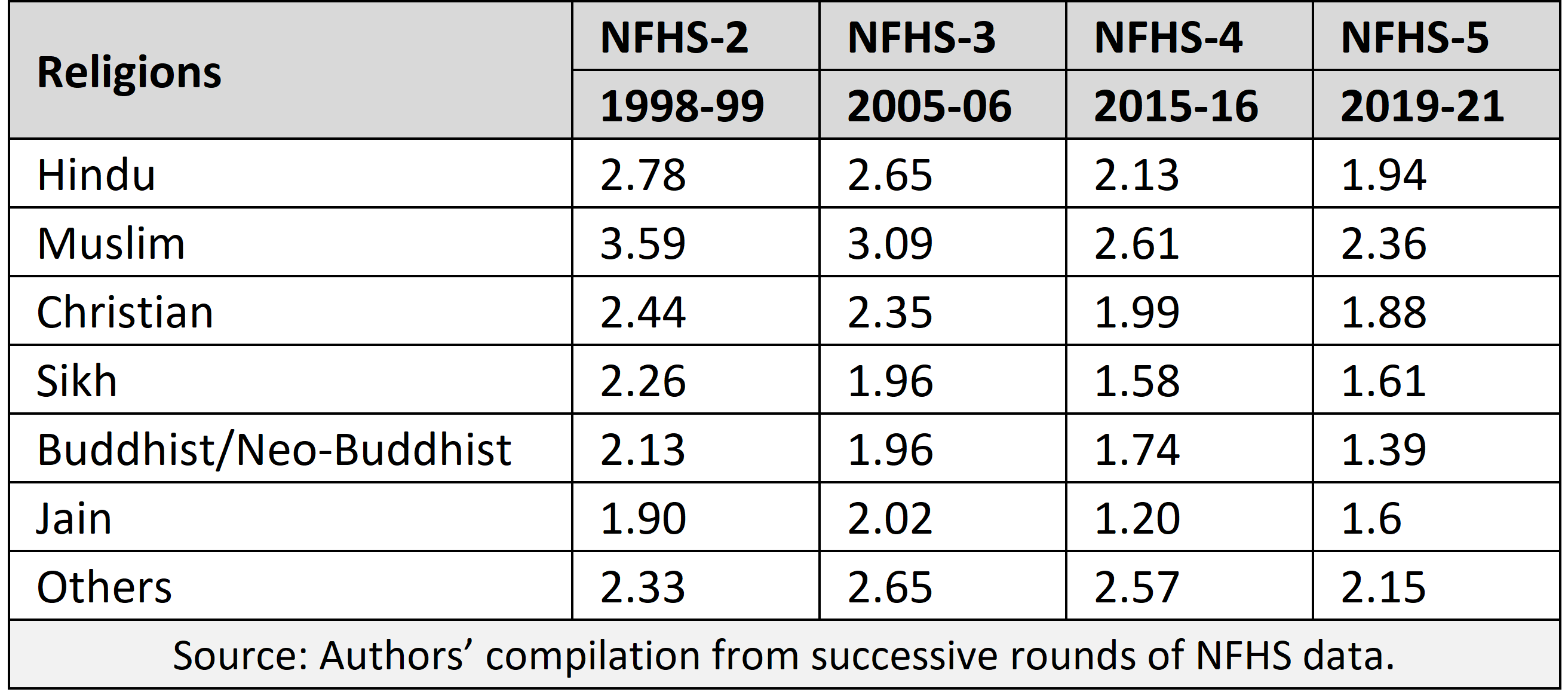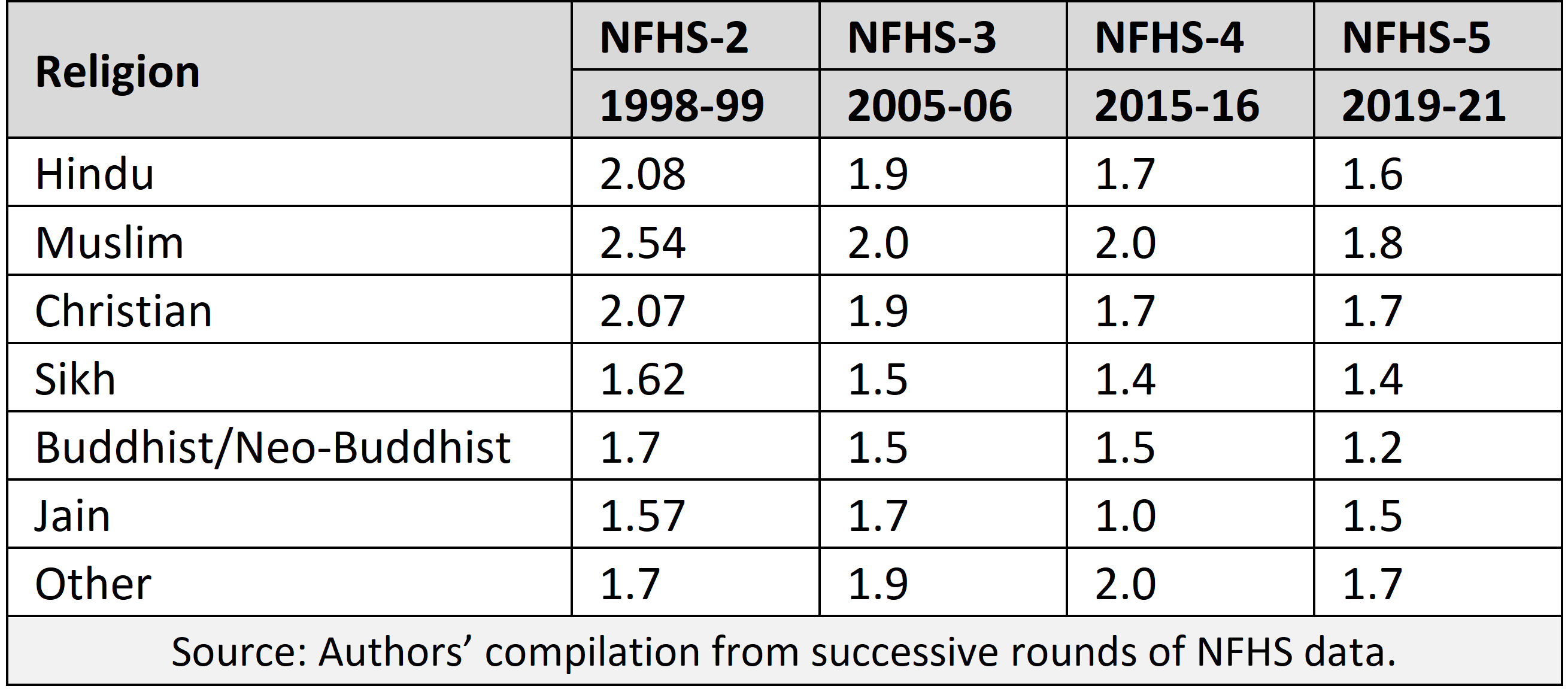Global fertility levels had fallen to 2.3 births per woman in 2021 from an average of 5 births per woman in 1950. Over the last seven decades, global trends in fertility have exhibited a consistent decline and this has coincided with the fast converging of fertility rates across less developed and more developed nations, except for a few least developed countries (Figure 1). The global narrative on demographic regimes is therefore shifting from the concerns of overpopulation—that is, with too many individuals—to the looming threat of population decline—that is, with too few individuals. Indeed, most countries in the world now grapple with the concern of too few children rather than too many (United Nations 2022).
Over the last six to seven decades, a number of demographers, economists, environmentalists, and politicians have warned against a “burgeoning global population” overriding the earth’s carrying capacity (Malthus 1986; Ehrlich and Ehrlich 2009; Birdsall et al. 2001). In contrast to this, the demographic history of the world in the last 70 years shows that the worst effects of a population increase have been neutralised through extraordinary advances in agriculture, industry, poverty alleviation, education, urbanisation, healthcare, and family planning (Lam 2011).
A new alarm is now being sounded by population and development specialists over steeply declining populations in recent decades. Darrell Bricker and John Ibbitson in Empty Planet (2019) argue that the major upcoming threat to sustainable development worldwide is a sharply declining population. Despite this change in thinking over population concerns at a global level, Malthusian fears are still reflected in the population policies of developing countries such as India, where a section of political opinion and scholars continue to blame poor and underprivileged communities for higher fertility rates and population growth.
Figure 1: Trends in Fertility Rates in India and the World (number of children per woman)
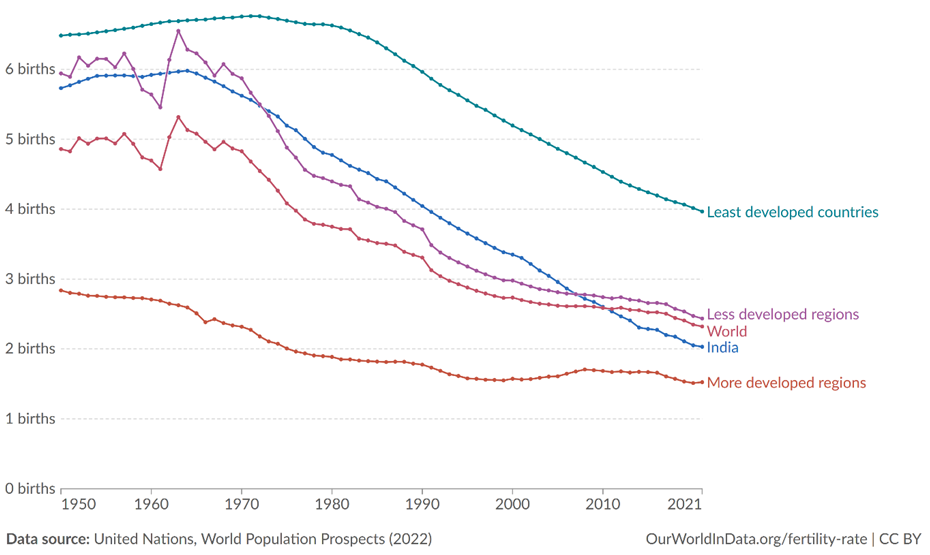
Fertility Transition in India
Fertility rates in India, compared to the global average, have exhibited a fast decline from around more than five children per woman in 1950 to two children per woman in 2021 (Figure 1). The country reached replacement-level fertility (that is, two children replacing two parents) in record time, and was the second fastest among major countries to do so—next only to China. Fertility rates in India are now closer to more developed regions in the world.
All Indian states, barring six, now have a fertility level below the replacement level. Even, some states have been stalling around slightly above one child per woman for more than a decade and a half (Shekhar et al. 2023).
Table 1: Length of First Demographic Transition in Select Countries

Fertility Rates across Socio-Religious Groups
One of the most contentious debates in India revolves around fertility rate differentials among Hindus and Muslims (Vora 2023). Likewise, caste-based fertility differentials also receive widespread attention. This has gained significant momentum in recent decades, with several political and state organisations demanding a caste-based census on the ground that the share of social groups in the population has shifted over time. Several academic studies have attempted to dispel long-held myths related to differentials in fertility rates among socio-religious groups, but misconceptions still abound (James and Goli 2016; Shekhar et al. 2023).
The figures from the fifth National Family Health Survey (NFHS), 2019–21, ought to put an end to the long-debated subject of Hindu-Muslim differentials in fertility rates. It shows that the fertility gap between Hindus and Muslims was just 0.42 children per woman in 2019-21, down from 1.1 in 1992.
In the last 20 years, fertility among Hindus has dropped by 30%, while the decline among Muslims has been 35% (Figure 2A). With a higher rate of progress in the decline of Muslim fertility, the Hindu and Muslim fertility rates are on the track to convergence, plausibly by 2030. Other religious groups such as Christians, Sikhs, Jains, and Buddhists have fertility rates lower than the replacement level.
The fertility patterns of social groups, although less discussed than religious differences, are important, given their direct implications for affirmative policies in the country.
The fertility rate of Buddhists is at a “lowest-low” level (defined as fertility rate<1.3). Jains had a similar fertility level during 2015-16, but showed a slight improvement after that. The fertility rate among these two communities is lower than that in several European and other developed countries (Appendix Table 1).
The fertility patterns of social groups, although less discussed than religious differences, are important, given their direct implications for affirmative policies in the country. Until the advent of the NFHS, not much was known about child bearing patterns by caste. With the exception of the 1931 Census of India, no census provides information on births in all castes, and the Sample Registration System, a key source of information, is silent on both caste and religion-based demographic information (Office of the Registrar General and Census Commissioner, Various Years).
Analyses of trends in fertility rates for social groups from successive rounds of the NFHS suggest a similar story as that seen across religious categories. Although fertility decline began late among the Scheduled Castes (SCs), Scheduled Tribes (STs), and Other Background Classes (OBCs), recent NFHS estimates show that they are fast converging with the fertility rates of the other castes (Figure 2B). As of 2021, fertility levels among SCs, STs, and OBCs were below the replacement level of 2.1.
Figure 2: Average Number of Children per Woman by Religion and Caste in India, 1998 to 2021
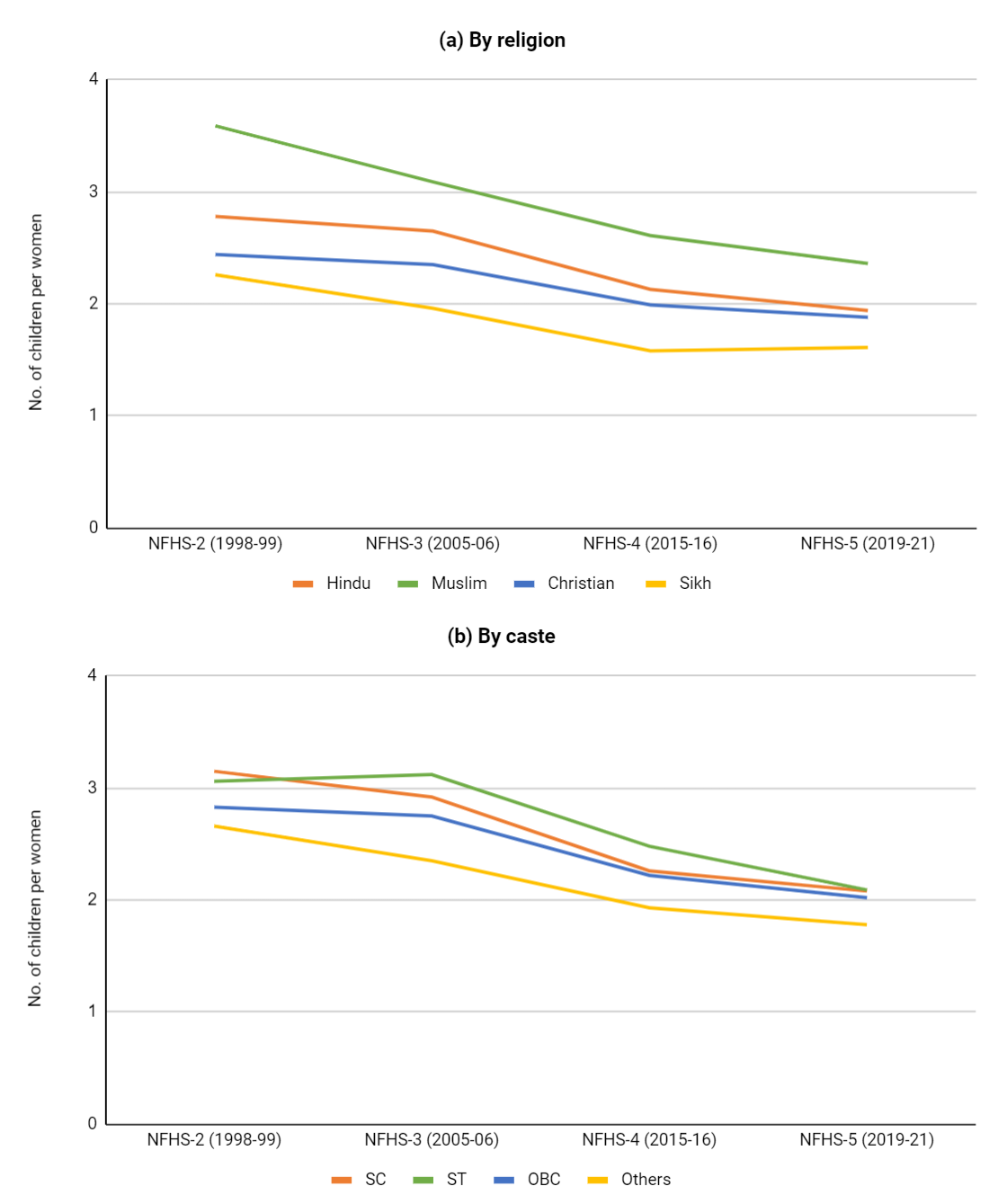
A country’s population policy discourses are more influenced by the number of children wanted or desired by women than by the total number of children per woman. The difference between these two markers of fertility levels points to unplanned or unwanted pregnancies among populations. Unwanted and unexpected births occur when women do not wish to have more children, but are compelled to do so because of the failure of contraceptives and/or a lack of access to quality family planning services (Shekhar et al. 2023).
The wanted number of births per woman across religious and social groups is way below the replacement level of fertility (Figure 3). We argue that the slight differences in the average number of children per woman among Hindus and Muslims, and SCs/STs/OBCs compared to the other castes (Figure 1) is plausibly because of disparities in an unmet need for family planning. That would indicate that neither Muslims nor any other socially disadvantaged community prefers a higher birth rate. Thus, effective family planning services could accelerate the convergence in fertility rates across social and religious groups in the country very soon.
Figure 3: Average Number of Wanted Children per Woman by Religion and Caste in India, 1998 to 2021
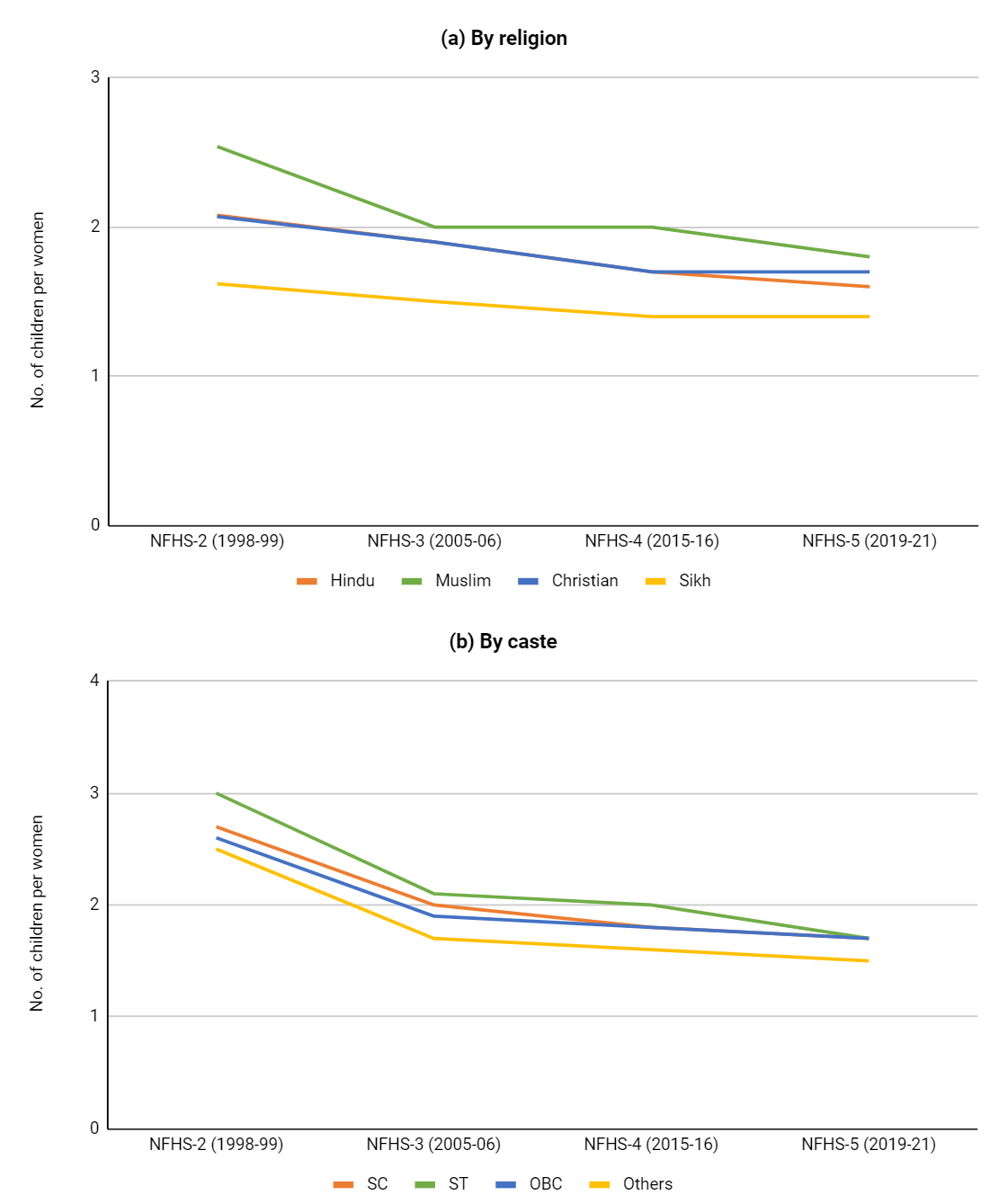
Do Religion and Caste Norms Matter?
The fast-emerging convergence pattern in fertility rates among social and religious groups dispels long-held myths about fertility preferences being significantly driven by religious and caste norms. Further, to substantiate the argument that religion and caste norms are not major contributors to determining fertility preferences compared to other socio-economic and regional factors, we conducted some additional analyses. We examined the heterogeneity in fertility preferences across the same religions and castes by their geographical location and socio-economic status.
The hypothesis is that if religion and caste are the major reasons for fertility preferences, the fertility rates of a specific religion and caste should be same irrespective of geographical location and socio-economic status. However, Table 2 suggests that Muslim fertility rates across the states of India are not uniform. For instance, in Jammu and Kashmir, the fertility rate of Muslims has reached the “lowest-low” level. Similarly, in Tamil Nadu, it is below replacement level, while it is around the replacement level in Kerala. However, Muslim fertility rates range from moderately high in Uttar Pradesh to very high in Bihar.
We can see that the fertility rate of SCs is well below the replacement level in Kerala, Tamil Nadu, and Jammu and Kashmir, while it is moderately high in Uttar Pradesh to very high in Bihar. As a matter of fact, the fertility rate of SCs is lower than the general castes in Kerala.
Table 2: Fertility Rates by Social and Religious Groups across Select States, 2021

Table 3: Fertility Rates by Social and Religious Groups across Select Socio-Economic Categories, 2021

The findings in Table 3 clearly suggest that differences in fertility rates among Hindus by education and economic status is higher than the difference in fertility rates between Hindus and Muslims. Similarly, differences in fertility rates among Muslims by education and economic status are higher than the difference in fertility rates between Hindus and Muslims.
The evidence suggests that only 15% of the change in fertility rates between 1998 and 2021 is explained by changes in fertility preferences across social and religious groups, while 85% is explained by socio-economic status and access to family planning services.
The differences in fertility rates between castes groups are much smaller than the difference in fertility rates by education and economic status within each caste group. This suggests that rather than religion and caste, fertility is mainly driven by other socio-economic and regional factors and effective health policies.
By comparing the wanted number of births shown in Figure 3 and the unmet need for family planning in Figure 4 across different social and religious groups, it is reasonable to say that lack of access to quality family planning services is one of the major reasons for unwanted births. Currently, 11.8% of Muslim and 9.0% of Hindu women report an unmet need for family planning. Women from other social and religious groups also reported a significant percentage of unmet needs for family planning (Figure 4).
Finally, to strengthen the arguments, we have decomposed the change in fertility rates that measure the relative contribution of religion and caste norms vis-à-vis other socio-economic endowments and family planning services. The decomposition results are presented in Figure 5 (for technical details, see Gupta 1993). They clearly suggest that only 15% of the overall change in fertility rates between 1998 and 2021 is explained by changes in fertility preferences across social and religious groups, while 85% is explained by socio-economic status and access to family planning services. Thus, the net contribution of religion and caste norms to fertility behaviour is very small.
Figure 4: Unmet Need for Family Planning by Religion and Caste in India, 1998 to 2021
(Percentage of women reporting unmet family planning need)
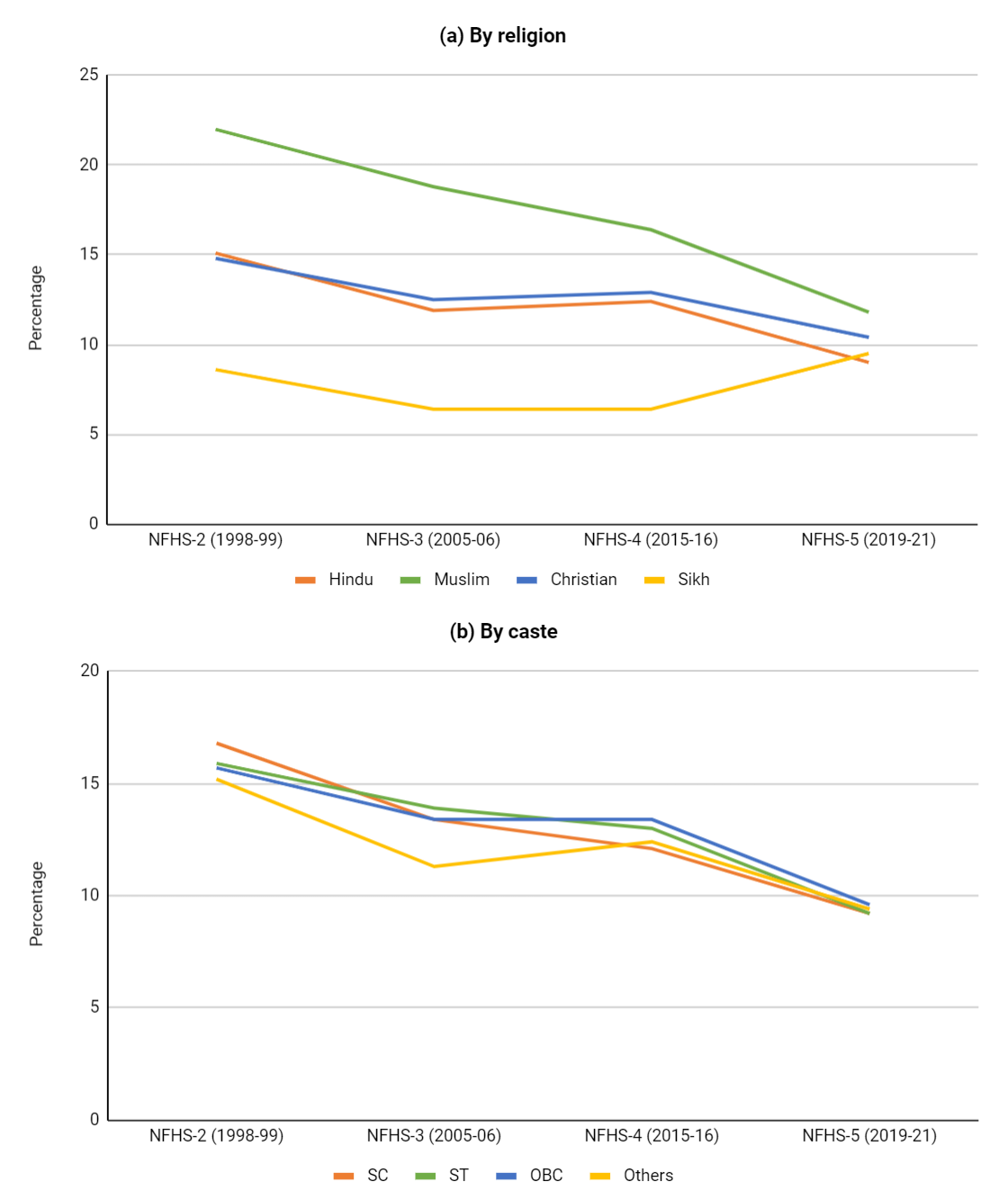
Figure 5: Relative Contribution of Religion and Caste versus Other Factor to Fertility Change in India from 1998 to 2021
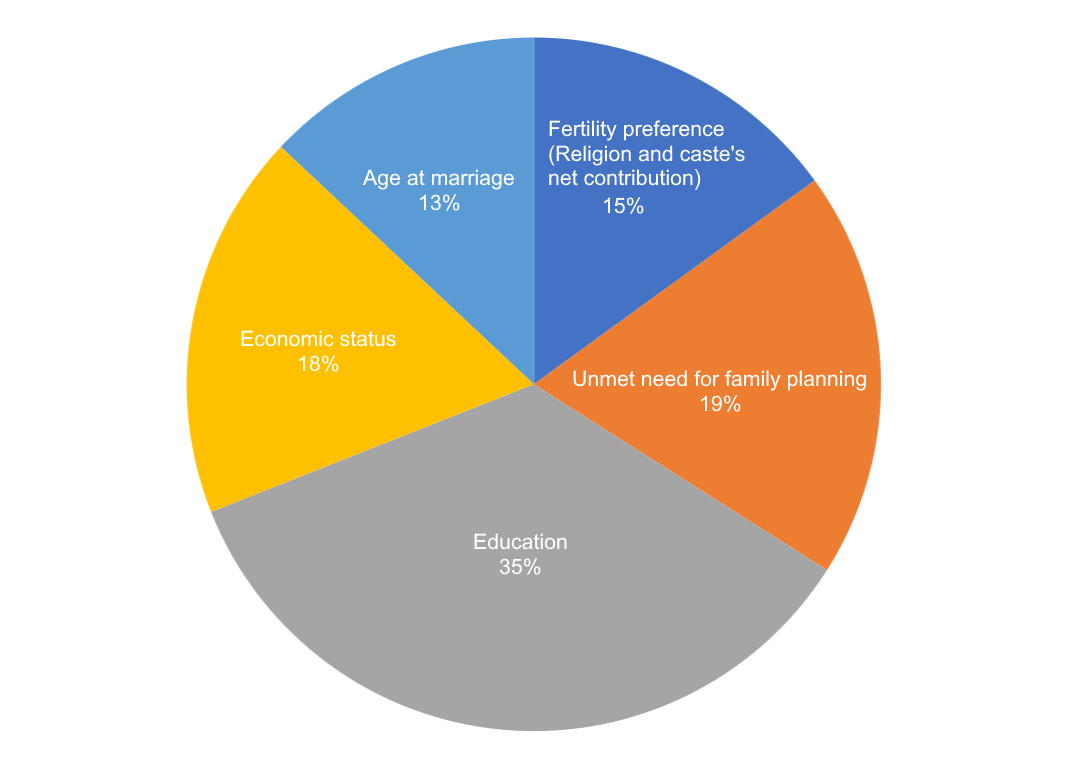
Concluding Remarks and Policy Priorities
In today’s scenario, there is a lack of robust evidence to prove that religious and caste norms alone influence fertility rates and population growth in a major way. As apparent from what has been discussed, both Hindus and Muslims today not only want more or less the same in general, but also a fewer number of children. A similar pattern is seen between SCs and OBCs, and the general castes.
For instance, Muslim women in Jammu and Kashmir and Kerala have fewer births than Hindu women in Uttar Pradesh and Bihar. Similarly, Kerala’s Dalits have much lower fertility than the general castes in many other states, including Kerala. Thus, population policies need to pay more attention to meeting the unmet need for family planning, mitigating poverty, and ensuring child survival to stabilise the population, especially in demographically backward states. More importantly, women’s education and employment status are also key factors that influence childbearing patterns among any population group (James and Goli 2016; Shekhar et al. 2023).
Considering the fast declining fertility levels across all social and religious groups in India, the discourse must move away from attributing the growth in population to specific communities.
However, the real consideration for population policymakers in India should be the ongoing “demographic window of opportunity”. The evidence suggests that the current demographic structure of India is advantageous rather than disadvantageous, especially because a fertility rate of anything below 1.8 is non-economical (Goli et al. 2023). Declining birth rates around the world are causing a serious panic among the political class and policymakers. A few even believe that shrinking populations can be the next biggest threat to geopolitics and sustainable development (Bricker and Ibbitson 2019). Currently, 128 of the 197 countries around the globe either want to raise their fertility level or maintain their current level (United Nations 2021).
Considering the fast declining fertility levels across all social and religious groups in India, the discourse must move away from attributing the growth in population to specific communities. We must also avoid state-induced, coercively targeted population control programmes. The country should instead focus on the health, skills, employment, and overall well-being of the population as a whole for reaping a demographic dividend and ensuring a stable population, without violating human rights.
Srinivas Goli is an Associate Professor and Shubhra Kriti is a PhD scholar at the International Institute for Population Science, Mumbai.











